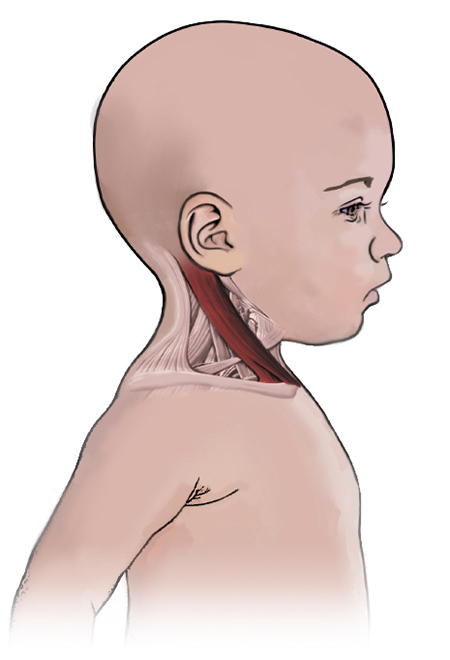Torticollis is a tightening of the sternocleidomastoid (SCM) muscle (i.e., the muscle that runs from the base of the neck, at the level of the collarbone, to the base of the skull behind the ear).
The Action of the SCM
The muscle bends the head to the same side and turns the head away in the opposite direction.
Range of Motion (ROM)

There are two different types of ROM that we refer to often in physical therapy for torticollis.
- Passive Range of Motion (PROM): Muscular exercise without any effort on part of the patient. Also called “stretching”.
- Active Range of Motion (AROM): The range of movement at a particular joint that a patient can accomplish without assistance. Also called “strengthening”.
There are two motions that we typically stretch and strengthen for torticollis.
- Lateral flexion: The motion of bringing your ear to your shoulder.
- Rotation: The motion of bringing your chin toward your shoulder.
Positioning
Promotes improved head position and increases passive range of motion (PROM) and active range of motion (AROM).
Because children develop many skills before they begin standing or walking, we recommend that they spend time in a variety of floor positions. We advise parents to minimize the use of infant positioning equipment such as infant swings, bouncy seats, infant wraps/slings, and infant/toddler rockers. Limit your baby's time in car seats and strollers to only be the time spent in transport.
In addition, we recommend that children diagnosed with torticollis spend time on their tummies and moving in and out of the tummy position. Activities that promote this movement will improve neck strength, which is the main goal of treating children with torticollis. You’ll be given information about supervised “tummy time” activities throughout your therapy visits. To help your baby make progress, it is important to complete daily exercises at home as your physical therapist instructs.
Please ask your therapist if you have questions regarding your home exercise program.
This information is for educational purposes only. It is not intended to replace the advice of your health care providers. If you have any questions, talk with your doctor or others on your health care team.
If you are a Gillette patient with urgent questions or concerns, please contact Telehealth Nursing at 651-229-3890.
 Home Page
Home Page
